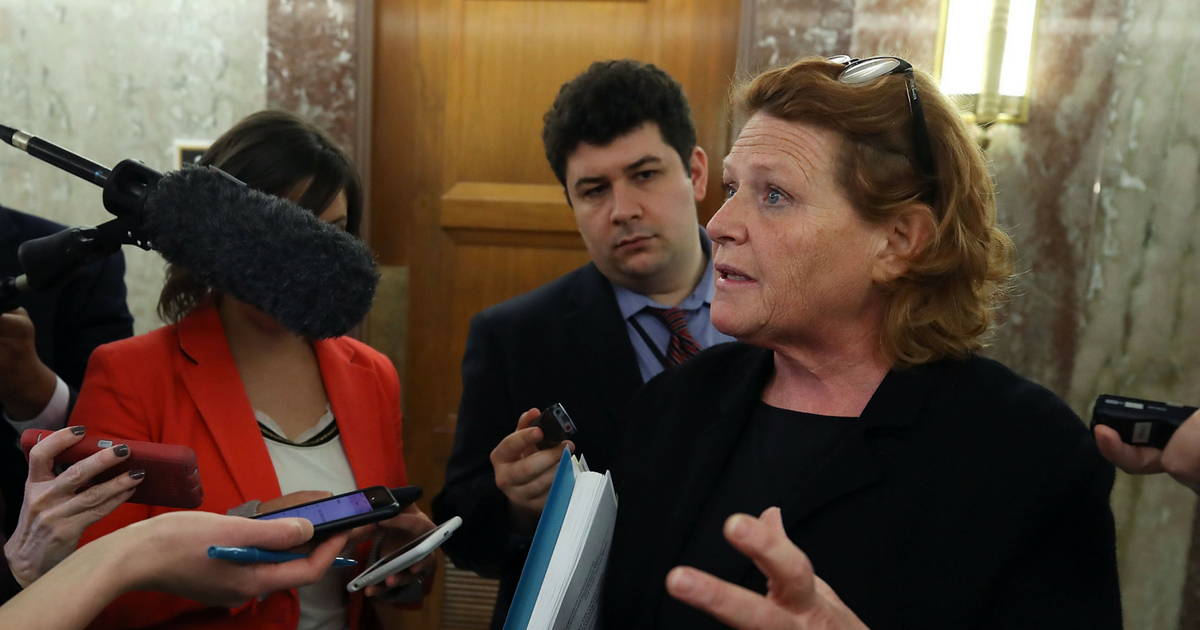
Fact Check: Democrat Senator Caught Lying About Obamacare's Importance
U.S. Sen. Heidi Heitkamp says in a television ad released last week that 300,000 North Dakota residents with pre-existing medical conditions couldn’t get health insurance before former President Barack Obama’s health care law.
Health care is a big issue in midterm races across the country, and has become especially charged in North Dakota, where Heitkamp’s re-election race against Republican U.S. Rep. Kevin Cramer is seen as critical to control of the Senate.
Heitkamp’s ad features a North Dakota woman, Denise Sandvick of Killdeer, speaking to the camera to ask Cramer why he wants to undo protections in the Affordable Care Act for people with pre-existing conditions. Heitkamp says in the ad that Sandvick suffers from heart disease while also mentioning Heitkamp’s own battle with breast cancer. Heitkamp herself does not mention Obama’s health care law.
A look at the claim:
HEITKAMP: “Like 300,000 North Dakotans, Denise has a pre-existing condition. That used to mean no health insurance.”
THE FACTS: Heitkamp is about right on the number of North Dakotans who have pre-existing conditions, but she overstates the number who wouldn’t have been able to get health insurance.
Heitkamp’s estimate on the number of North Dakotans with pre-existing conditions is a bit higher than the state’s figure of 275,000. The senator’s estimate comes from the left-leaning Center for American Progress, but both the center and North Dakota’s insurance department worked from an analysis by the U.S. Department of Health and Human Services.
But the number of those people who might have had problems getting health insurance before the federal overhaul __ and who would have trouble if it were to be repealed __ is far smaller. That’s because most of the state’s residents are insured through their employer or the government.
The most recent data break it down.
North Dakota has about 755,000 residents. State Insurance Department figures from 2017 show more than 415,000 have employer health plans that cover people with pre-existing conditions. Almost 220,000 more were covered by government programs such as Medicare and Medicaid, which both now and before the ACA did not make preexisting conditions a barrier to coverage.
That leaves about 60,000 who were on private insurance — and that’s the group that, before the ACA, was most at risk of being denied coverage if they had a pre-existing condition. The state had an additional 60,000 people who don’t have health insurance, but it’s unclear how many in that group have a pre-existing condition.
Before the Affordable Care Act made it illegal to do so, any insurer could deny any pre-existing condition for anyone under individual plans, said Paul Ginsburg, a health policy expert with the nonpartisan Brookings Institution.
But federal rules both then and now forbid discrimination against someone with pre-existing conditions under an employer health plan, he said.
HHS data show 14 percent of people with pre-existing conditions nationwide were uninsured before the ACA. That dropped to 11 percent when the law went into effect in 2014. During the same period, the number of Americans with pre-existing conditions insured by their employers remained constant, at about 67 percent.
On Wednesday, Heitkamp clarified her claim to reporters.
“In no way did I ever say half the people in North Dakota weren’t covered by health insurance,” she said. Heitkamp said she meant 300,000 people would be in danger of losing pre-existing health coverage.
Heitkamp’s campaign said in an email the intent of ad was to highlight the impact of repealing the Affordable Care Act.
The Western Journal has reviewed this Associated Press story and may have altered it prior to publication to ensure that it meets our editorial standards.
Truth and Accuracy
We are committed to truth and accuracy in all of our journalism. Read our editorial standards.
Advertise with The Western Journal and reach millions of highly engaged readers, while supporting our work. Advertise Today.











